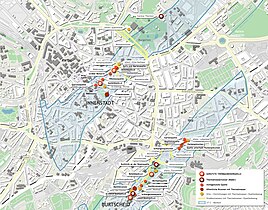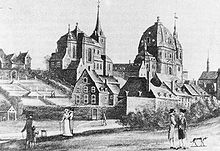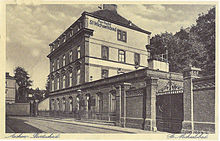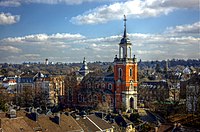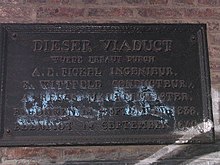Burtscheid
|
Burtscheid
City of Aachen
|
|
|---|---|
| Coordinates: 50 ° 45 ′ 47 " N , 6 ° 5 ′ 32" E | |
| Height : | approx. 180 m above sea level NN |
| Incorporation : | April 1, 1897 |
| Postal code : | 52066 |
| Area code : | 0241 |
|
Site plan Burtscheid and its thermal springs
|
|
Burtscheid ( Latin Porcetum , French Borcette , Öcher Platt Botsched ) is a former town and today's district of Aachen . The village was first mentioned in a document on January 21, 1018, but was previously settled by Celts and Romans. In 1338 Burtscheid received city rights ; In 1816 it became the administrative seat of the Aachen district . On April 1, 1897, Burtscheid was incorporated into Aachen and has been part of the Aachen-Mitte district since 1972 . Burtscheid owes its origin and later economic and social development mainly to its more than 20 thermal spring precursors , which belong to the Aachen thermal spring system, as well as the worm with its inflows . In addition to the center, the districts Beverau , Steinebrück and the Frankenberger Viertel belonged to the former city .
Origin of name
The name Burtscheid is a compound that allows various interpretations. First of all, the basic word ... divide a territorial border, a road or watershed. Another interpretation is related to the settlement. During the major clearing in the 12th and 13th centuries Numerous settlements with the syllable ... Scheid in the name emerged on the left bank of the Rhine . The word is interpreted in different ways: it can mean the land that has been separated for the settlement or the name is related to the older Celtic / Gallic word keiton / cetum in the meaning of forest / heather .
In earlier spelling, Burtscheid is called borcetum - which can be interpreted in its meaning either as forest on the Bieberbach (= Beverbach ) , forest on the brown brook , forest for pigs .
coat of arms
The old city coat of arms of Burtscheid was developed from the family coat of arms of the abbess von Woestenrath and the two double-tailed lions come from the Jülich coat of arms. In detail it was structured as follows:
Blazon : In black, gold margins, a golden 12-endiges Stag, is a silver swan. The shield, crowned with a three-towered silver city wall (reference to a city coat of arms) and held by two upright, double-tailed golden lions, stands on a silver ribbon that bears the inscription Stadt Burtscheid .
When Burtscheid took over the administrative headquarters of the Aachen district in 1816, the previous shield with the antlers and the swan but without the towers, the lions and the silver ribbon, was now supplemented with a golden (yellow) shield head above the old coat of arms , in which the black Jülich (standing for Duchy of Jülich ) lion walks to the left and has served as the coat of arms for the entire former district of Aachen and today's urban region of Aachen .
History, general
The Celts already settled in this area along one of the Wurm springs at that time and probably gave the brook its current name as a derivation of the word 'warm', as it had relatively warm water due to the influence of the thermal springs , this theory being the Naming is historically not proven. They dedicated this source to their god Grannus . The Celts used a source of cool and clear water located a little higher up in the nearby city forest, which is now regarded as the actual worm source.

The Romans later settled here and named the area Porcetum because of the presence of wild boars . In the area of today's Burtscheider market, Roman thermal facilities and medical cutlery from Roman times were found, which indicates the settlement as a spa and medicinal bath. So that the valuable drinking water from the Aachen forest , which flows in the Burtscheider Valley towards Aachen, is not contaminated by the salty thermal water and thus unusable for the water supply, the Romans relocated the worms in the area of the source area of the thermal springs. The artificial watercourse of the Cold Bach runs on the slopes of the Heißberg and Adlerberg to the Frankenberg district. Subsequently, Germanic - Franconian tribes settled the area, before later in the 7th century the Arnulfingers under Chlodulf had a chapel built here and in the following Carolingian period Burtscheid was probably converted into a side courtyard of the Aachen Imperial Palatinate with cattle farming.
Burtscheid owes its actual development as a city to the Benedictine monastery Burtscheid , which according to a diploma from Emperor Otto III. was founded on February 6th of the year 1000 as an imperial foundation under the Basilian Abbot Gregor von Burtscheid from Calabria in honor of St. Nicholas of Myra and Apollinaris of Ravenna . Evidence and most sources suggest that 997 was the actual year of foundation. In 1220, the Benedictine monastery was converted into a Cistercian women's monastery that was directly part of the empire . The abbesses of the monastery with a seat and vote in the imperial assembly were now responsible for the state sovereignty over Burtscheid as prince-abbesses for around 570 years. To enforce their sovereign rights, they were each assigned a bailiff . The function of bailiff was taken over by the lords of Merode-Frankenberg, a branch of the Merode family with headquarters at Frankenberg Castle , until the beginning of the 17th century . The rights of the Obervogts were incumbent on the Duke of Limburg and from 1288 on the Duke of Brabant . In 1649, the bailiff's rights could be acquired by the abbey itself after the last hereditary bailiff, Johann Dietrich von Merode-Frankenburg, died in 1645 and his son Franz Ignaz was not yet of age. The abbesses then referred to themselves as hereditary bailiffs.
As early as 1351, the abbess Mechtildis von Bongard signed a contract with the Free Imperial City of Aachen, in which the latter received the judicial rights over the glory of Burtscheid and in return was prepared to promise the ongoing maintenance of the departmental freedoms. Since then, the Burtscheider city administration has been taken care of by a Meier appointed by the city of Aachen and his aldermen. In detail, the following Meier are proven:
- around 1352: Conrad von Raboitraide
- 1382-1389: Colyn Vollmer
- During the 15th century: Lambrecht Buck, senior and junior, and Peter Bu (e) ck
- then: Dederich von Haren
- from around 1545–1566: Gerhard Ellerborn
- from around 1580–1598: The Catholic Bonifacius Colyn , who was banished from the empire and deposed in 1598 in the course of the Aachen religious unrest because of his advocacy for the Reformed
- 1598–1605: The Catholic Albrecht Schrick was appointed Meier at the height of the religious unrest, but was deposed by the current Protestant majority in August 1605.
- 1605–1612: Egidius Bleyenheuft was initially appointed as Schrick's successor, but was replaced by him a few weeks later after his rehabilitation. Schrick was released again in 1612.
- 1612–1612: Ludolf von Linzenich was appointed by the now evangelical majority in the council, but died a few weeks after he was sworn in
- 1612–1614: Johann Kalkberner , elected mayor of Aachen, took over the office in personal union ; was not accepted by the bailiff and outlawed in 1614
- 1614–1640: Albrecht Schrick was reinstated in the Meieramt
- 1640–1644: Balthasar Fiebus the Elder
- 1644–1665: Gerlach Maw
- 1665–1678: Nikolaus Fiebus
- 1678–1681: Mathias Maw
- 1681–1705: Johann Chorus
- 1705-1728: Cornelius de Fays
- 1728–1756: Martin Lambert de Lonneux
- 1756–1778: Johann Joseph Niclas
- 1778–1793: Stephan Dominicus Dauven
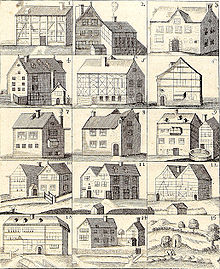
From around the time the city rights were received, the Wurm marked the border between Burtscheid and the neighboring Free Imperial City of Aachen and between the Diocese of Liège and the Archdiocese of Cologne . During the time of the Aachen religious unrest, many families who had converted to Protestantism , such as Pastor , Peltzer and Amya, fled from Aachen, which was ultimately dominated by Catholics, and settled in Burtscheid, among others. Here they could practice their religion relatively freely and pursue their craft in peace. These families in particular, who had found refuge in Burtscheid, founded numerous mills , hammer mills , dye works , grinding shops , cloth manufacturers and other factories and used the water from the worm and its inlets as a driving force for their grinders.
From June 30, 1802, Burtscheid became Mairie and the capital of the canton of Burtscheid . In the Prussian era that followed from 1815, the former canton of Burtscheid was merged with the previous canton of Eschweiler to form the new district of Aachen , and Burtscheid was designated as the new administrative center. This merging found its expression in the new coat of arms, which is composed of the Burtscheid coat of arms with the swan in the deer antlers and the Jülich lion of the Eschweiler coat of arms. The city of Burtscheid itself, in which around 11,000 inhabitants already lived, around 11% of whom were Protestant, was administered by a mayor's office. The incumbent mayors have documented and known:
- from 1829 to 1834: Barto von Löwenigh
- from 1850 to 1862: Christian Wilhelm Kropp
- from 1862 to 1872: Johann Peter Wilhelm Klausener
- from 1872 to incorporation in Aachen in 1896: Karl Middeldorf
The sewer system as well as the gas and water pipes were built in cooperation with the city of Aachen. The first horse-drawn tram ran between the cities and the shared Aachen main station was built on the city limits between Burtscheid and Aachen in 1841 . In Burtscheid , small and medium-sized handicrafts in particular flourished, consisting of cloth , deerskin and cashmere factories , then carded and worsted spinning mills , mechanical weaving mills , dye works , a felt cloth factory , factories for needles , scrapers , machines, safes and chemicals, an iron foundry, colored wood mills as well a beer brewery and brandy distillery . They merged with Aachen in 1833 to form the common chamber of commerce for the cities of Aachen and Burtscheid , which later became the Aachen Chamber of Commerce and Industry .
During the same period, the spa and bathing facilities were very popular, new spa facilities and new hospitals were built and, thanks to its hot springs, Burtscheid developed into a health resort that is still recognized today , especially for diseases of the rheumatic type .
Finally, after years of tough negotiations, on January 28, 1896, a few months before the Mayor of Aachen, Ludwig Pelzer , came to an end , the contract on the incorporation of Burtscheid, which had meanwhile grown together economically and spatially with the city of Aachen, was signed by the city administration and by decided and approved by the royal state government. The resulting law was then signed on December 24, 1896 by Pelzer's successor, Lord Mayor Philipp Veltman , and Karl Middeldorf, the last Burtscheid mayor in office since 1873, and countersigned by King Wilhelm II on March 29, 1897. Burtscheid forms one of the districts of Aachen . With the territorial reform in North Rhine-Westphalia through the Aachen law , Burtscheid was assigned to the Aachen-Mitte district in 1972 .
Chronology of the history of Burtscheid
1016-1018, about 20 years after the monastery was founded, the first ( Romanesque ) abbey church was completed and placed as a Benedictine abbey under the patronage of John the Baptist . Nikolaus von Myra remained the second patron. The church standing in this place today still bears the name St. Johann-Baptist .
On January 21, 1018, Emperor Heinrich II donated the surrounding area to the monastery as a tenth district , replacing it from the Palatinate district of Aachen. This resulted in the glory of Burtscheid .
In 1040, Emperor Heinrich III. the faithful living in the village of Burtscheid, who until then belonged to the parish of the Aachen Marienstift , the imperial abbey of Burtscheid.
After 1100 the abbey was reformed from Siegburg and flourished until the end of the 12th century. Around 1190, under Abbot Arnold, the bones of the founding abbot Gregor von Burtscheid were solemnly raised in honor of the altars. The day of Gregory's death, November 4th 999, was celebrated as a day of remembrance until the abbey was abolished.
At the beginning of the 13th century, a parish church was built right next to the abbey church , which was consecrated in the name of St. Michael .
In 1220/21, under Emperor Friedrich II and Archbishop Engelbert I of Cologne , who was responsible for Burtscheid and who was also Chancellor of the Holy Roman Empire , the Benedictines were expelled from the monastery. In their place, Cistercian women moved into the buildings that had previously been located on the Salvatorberg in Aachen from around 1200 . All property and rights of the monastery were transferred to these nuns . The monastery supervision was initially incumbent on the Abbey of Heisterbach , from the 14th century on the Abbey of Himmerod and from the 16th century on the Abbey of Clairvaux or the subordinate Abbey of Val Dieu (today Belgium ).
In 1248 Aachen and Burtscheid were besieged by Count Wilhelm von Holland . The monastery buildings suffered severe damage. In 1252, to compensate for the damage, the parish church of St. Michael of the Abbey, which had already owned the patronage of the "Leutkirche" (since the 13th century from Latin ecclesia plebis - people's church, Leutkirche, main church of a parish, synonymous with parish church), the incorporation granted and with it the permission to collect the big tithe and the fruit tithe . The status of a Rector church was St. Michael to the secularisation under Napoleon I get.
Around 1300 the Burtscheider cloth makers joined together in a guild for the first time .
In 1306, Frankenberg Castle , located on Burtscheider territory, was first mentioned in a document. Presumably it was built by Knight Arnold around 1270. It was the seat of the Burtscheider bailiffs until the beginning of the 17th century.
In the middle of the 14th century the Romanesque abbey church was demolished and a three-aisled Gothic church was built in its place .
On October 23, 1351, the abbey transferred jurisdiction over Burtscheid to the city of Aachen, which was then exercised by an Aachener Meier .
Around 1634 the foundation stone for the first Protestant church was laid on the main street, but after only 80 years it was demolished again in 1714 by imperial order.
Between 1735 and 1754, the abbey church of St. Johann Baptist was rebuilt under the abbesses of Renesse and von Woestenrath by the architect Johann Joseph Couven . Between 1748 and 1751 he also rebuilt the parish church of St. Michael, which was later expanded in 1891/92 by the architect P. Peters.
Between 1753 and 1775 there were disputes between the imperial city of Aachen and the imperial abbey of Burtscheid about new roads to and from Burtscheid.
Despite the objection of the Aachen council, gambling was introduced by the abbess of Krugenofen in 1779 . That is why the extension of the street Krugenofen is now called Kasinostraße .
In December 1792, the first occupation of Burtscheid by French troops took place. The final occupation took place in September 1794 and lasted until 1814. Burtscheid became a canton in the Département de la Roer . The occupiers set up a freedom tree and misused the abbey church as a research facility for the production of hot air balloons . On June 30, 1802, Burtscheid became Mairie and the capital of the canton of Burtscheid . In August of the same year the French dissolved the monastery convent, expelled the nuns and secularized the monastery property . The abbey building was now used for apartments, schools and administration.
On March 1, 1804, St. Michael became a cantonal parish with 17 auxiliary parishes, and the Burtscheid pastor was given the title of senior pastor. The new Reformed Church on Hauptstrasse was also consecrated that year. It was not until the end of the 19th century that the Burtscheiders received a Protestant parish church again with the Trinity Church , which was opened and inaugurated in 1899 .
On March 23, 1816, Burtscheid became the capital of the Prussian district of Aachen-Land, which was formed from the former French canton of Burtscheid and the canton of Eschweiler , and thus the seat of the district administration and the district administrator. The seat of the Aachen city region is still located in the renovated and expanded building complex as the successor organization to the former Aachen district .
On March 3, 1823, the foundation stone of the Burtscheid town hall was laid, which until recently was the guest house and has now been converted into the "House of Hearing" (architect Ulich).
In the years 1831/32, 1849 and 1866 there were several cholera epidemics as well as strange cases of intermittent fever , also known as "Burtscheider disease". For this reason, the cholera cemetery , today's forest cemetery , was built in 1832 , which was later expanded to become a cemetery of honor for those who died in the two world wars . Within this area, Aachen citizens had the Bismarck Tower, inaugurated in 1907, built in memory of the "Iron Chancellor" .
The Burtscheider Viaduct was built in 1838-40 and the Cologne-Aachen-Belgium railway line of the Rhenish Railway Company , which runs over the viaduct , was opened on September 1st .
The site on the Heißberg was acquired by the community on October 23, 1851 to establish a new city cemetery. In 1852 the decision was made to build a surrounding wall, which was carried out by the contractors B. Klausener & Rhoen . In 1862, the hot mountain cemetery was opened for both denominations and in return the church yards of St. Johann and St. Michael were closed. War memorials for those who fell in the German War in 1866 and in the Franco-German War in 1870/71 were also erected on the Heißbergfriedhof .
On April 1, 1853, a citizens' initiative of the two Catholic parishes led to the foundation of the Marienhospital Aachen .
In 1874 the Frankenberg corporation was granted the concession to develop the Frankenberg district around Frankenberg Castle, which lasted until the First World War . This resulted in numerous houses whose facades during the early days in a historicist style ( neo-classicism , Neo-Renaissance , Neo-Baroque , Neo-Gothic or mixed forms), then in a nichthistoristischen fantasy style or the forms of Art Nouveau were eventually created in strict forms as well. In the area of the Frankenberg corporation alone, more than 250 monuments are currently identified.
In 1876 the Catholic Burtscheider Citizens 'Association was founded as a citizens' initiative against Bismarck's laws on culture warfare.
In 1895, the Moltkebahnhof , which was built at the instigation of the Royal Railway Directorate in Cologne, was put into operation, which, located halfway between the Burtscheider Viaduct and Frankenberg Castle, was intended as an exclusive freight station to take account of the increased freight transport. After 1986 it was shut down and now serves as a storage area for a construction company and as a wilderness park.
On September 27, 1903, the inauguration of the new Marienkapelle Burtscheid took place, which was built on the site of an old wooden chapel from 1644 as a neo-Romanesque octagonal central building, with a two-storey gallery and stair turrets on both sides of the entrance. The old wooden chapel was replaced by a first stone building in 1693 and expanded in 1811/12.
On June 5, 1910, at the end of Victoriaallee, the Herz-Jesu-Kirche (colloquially: Frankenberger Dom ) was built after two years of construction as one of the few neo-Romanesque stone basilicas in the Archdiocese of Cologne based on designs by Josef Kleesattel . The mosaic above the altar is one of the largest in the diocese of Aachen after that in Aachen Cathedral .
From 1943 there was a labor education camp (AEL) in the village , in which workers from local companies were exploited for forced labor under concentration camp conditions.
On April 11, 1944, the heaviest air raid on Aachen during the Second World War took place with the focus on Burtscheid. Within 21 minutes, around 350 aircraft dropped 19 mines, 4,047 high-explosive, 34,200 incendiary and 8,685 phosphorus bombs in the entire Aachen city area, killing 1,525 people. A large part of Burtscheid was also destroyed and the churches of St. Johann, St. Michael and Herz Jesu were badly damaged.
Spa services
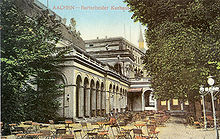
The thermal springs have been an important factor in Burtscheid since the times of the Celts , of which more than 25 more or less productive ones arise on Burtscheid territory, including the Landesbadquelle, the hottest thermal spring in Central Europe with almost 74 degrees. The outlet temperature of the water is between 50 and 70 degrees from most springs. They are sodium - chloride - hydrogen carbonate baths containing hydrogen sulphide or fluoride with a pH value of 6.8 to 7.2.
These are preferably used for rheumatic diseases, gout , neuralgia , paralysis , skin diseases , syphilis and for rehabilitation after operations and accidents internally and as baths.
In addition, well-tended parks such as the Kurpark Burtscheid , the Ferberpark Burtscheid and the nearby Aachen forest ensure a pleasant air climate that promotes healing.
In terms of sources, several sometimes very sophisticated bath houses were built, including the Goldmühlen- and Prinzenbad that Neubad as well as the still existing health clinic for Rosenquelle that Schwertbad and the Rheumatology Clinic, the former Landesbad the country Rheinprovinz . For those patients who were dependent on charitable support, the Association for the Support of Unprofitable External Wells or Bathers at the Mineral Springs of Aachen and Burtscheid was founded in 1835 , which made it possible to care for these patients. This association had the Krebsbad and the Michaelsbad built for its spa guests .
Well in Burtscheid
In the tradition of popular water, the Burtscheid team had some neat fountains built, two of which were moved from Aachen to Burtscheid and rebuilt. Some of the Burtscheider fountains have thermal water from their own springs. The most famous Burtscheider fountains are:
- Burtscheid thermal fountain, popular thermal water drinking fountain
- Cooking fountain , thermal water fountain
- Couven wall fountain
- Seahorse fountain
- Water and life
- Water games (Burtscheid)
Educational institutions
From 1824 to 1840, various municipal, parish, Sunday and evening schools were built in Burtscheid. In 1862 the Protestant school in Kapitelstrasse and the Michaelsbergstrasse school were added. Some schools and individual university departments that had previously existed in the city of Aachen also relocated to Burtscheid. In addition to five primary schools, two special schools, one each with a secondary school and a secondary school, there are currently three vocational schools in Burtscheid including the following educational institutions:
- Rhein-Maas-Gymnasium Aachen , founded as a Prussian Realgymnasium in Aachen, was relocated to Burtscheid under a new name in 1962 and today meets the criteria of a European school .
- Einhard-Gymnasium Aachen , originally founded as Kaiser-Wilhelm-Gymnasium in Aachen. After the Second World War, it was relocated to Burtscheid under a new name.
- Victoria School ; High school of the Evangelical Church in the Rhineland , founded as a secondary school for girls .
- Maria Montessori comprehensive school
- Viktor Frankl School, Rheinische Förderschule Aachen
- Catholic University of North Rhine-Westphalia , Aachen department
- FH Aachen , Campus Bayernallee,
Sports
The Burtscheider gymnastics club has its headquarters in the sports facility "auf Siegel" and offers a wide range of sports with its gymnastics, football, table tennis and trend sports departments. The sports club BTB Aachen has its home in the hall at the Ludwig-Kuhnen-Stadion in the Gillesbachtal and also offers various offers in popular sports, with handball playing the dominant role in the club. In addition, the quarter is home to the soccer clubs Blau-Weiß Aachen, VfL 05 Aachen, Burtscheider FC and the American Football Club Aachen Vampires 2005 e. V. Burtscheid is also home to the pétanque club Boule de Borcette eV , which trains in the boules facility in the Ferberpark.
Sons and daughters
- Matthias Goswin Pelzer (1754–1814), Syndic of Aachen and President of the Canton of Aix-la-Chapelle
- Petrus Klausener (1782–1850), Trappist monk and abbot of Oelenberg Abbey
- Philipp Heinrich Pastor (1787–1844), cloth and needle manufacturer, President of the Aachen Chamber of Commerce
- Konrad Gustav Pastor (1796–1890), industrialist, the "Belgian pastor"
- Barto von Löwenigh (1799–1853), Burtscheid mayor and polar traveler
- Gottfried Pastor (1809–1899), wool manufacturer and secret councilor
- Friedrich Wilhelm Hackländer (1816–1877), writer
- Joseph Hubert Reinkens (1821–1896), theologian and bishop
- Franz Bock (1823–1899), canon and art historian
- Oskar Erckens (1824–1901), cloth manufacturer in Burtscheid and Grevenbroich, Privy Councilor of Commerce
- Rudolf Arthur Pastor (1828-1892), needle manufacturer and Kgl. prussia. Commerce Council
- Peter Bücken (1830–1915), landscape painter
- Aloys Dauzenberg (1831–1907), Catholic pastor
- Emil Lochner (1832–1900), Aachen cloth manufacturer
- Egidius Jünger (1833–1895), Roman Catholic clergyman and Bishop of Nesqually
- Friedrich von Halfern (1849–1908), Burtscheider cloth manufacturer, chief fire chief and dendrologist
- Emil Striebeck (around 1850–1900), process engineer
- Alfons Klausener (1853–1921), Deputy Mayor of the City of Aachen and member of the Prussian House of Representatives
- Karl von Pastor (1857–1919), district administrator of the Aachen district
- Rudolf Püngeler (1857–1927), district judge and lepidopterist
- Willy Pastor (1867–1933), culture and art critic, ethnic writer
- Fritz Rothe (1867–1958), chemist and entrepreneur
- Carl von Halfern (1873–1937), government official and politician of the German People's Party
- Hugo Cadenbach (1874–1943), district judge and entrepreneur
- Johann Maria Heimann (1878–1931), industrialist
- Karl Wiener (1879–1929), architect
- Franz Wolfgang Demont (1880–1964), Vicar Apostolic of Aliwal
- Kurt Johnen (1884–1965), pianist, music teacher and music writer
- Carl Arthur Pastor (1885–1960), banker and insurance company
- Heinrich Linzen (1886–1942), landscape and animal painter
- Fritz Kaldenbach (1887–1918), architect and graphic artist
- Ewald Mataré (1887–1965), painter and sculptor
- Jacques Königstein (1897–1971), founder of the Order Against Animal Seriousness
- Hermann Jansen (Vicar General) (* 1904; † Cologne), Vicar General of the Archbishop of Cologne
- Rolf Thomas (1934–2016), priest and pastor
- Dieter Philipp (* 1943), association official and former president of the Central Association of German Crafts
- Armin Laschet (* 1961), politician ( CDU ), since 2017 Prime Minister of North Rhine-Westphalia
- Marcel Philipp (* 1971), politician (CDU) and Lord Mayor of Aachen since 2009
Personalities who worked in Burtscheid
- Heribert August (* 1947), pastor in Burtscheid 1983–2012
literature
- Karl Franz Meyer : Miscellanea Borcetano-Aquisgranensia or collection of various credible documents pertaining to the imperial freye realm city of Aachen, then the rulership of Burtscheid, together with the addition of some strange legal care that had an impact on the common being at the last place ; Aachen, 1772; [Two volumes of a collection of Aachen and Burtscheider documents as handwritten self-work in collaboration with the abbess of the Cistercian abbey in Burtscheid, whose special value for historians lies in the uniqueness of the unpublished work. They contain, among other things, the history of Burtscheid, the dairy farm, the unrest of the cloth makers, religious affairs and the fire in Aachen in 1656.]
- Original documents and message, such as the village and the glory of Burtscheid with all the people belonging to it, from Roman emperors and kings to the abbey there, and from this transferred to the mayor, Scheffen of the Royal See and Imperial Freyen, Imperial City of Aachen in 1351, continued as such transfer was confirmed and handled by the judgment of 1684. Müller, Aachen 1775. Digitized
- Johann Peter Joseph Monheim : The healing springs of Aachen, Burtscheid, Spaa, Malmedy and Heilstein, in their historical, geognostic, physical and medical relationships. Publishing house Jacob Anton Mayer, Aachen / Leipzig 1829.
- Christian Quix : The Frankenburg is commonly called Frankenberg and the Vogtei over Burtscheid. Matthias Urlich, Aachen 1829. (New edition: Kessinger Pub & Co., 2010, ISBN 978-1-161-27767-8 ).
- Christian Quix: Historical-topographical description of the city of Burtscheid. Verlag Jacob Anton Mayer, Leipzig 1832. (New edition: 1976, ISBN 3-87519-065-3 ).
- Christian Quix: History of the former Reichsabtei Burtscheid, from its foundation in the 7th century to 1400. Jacob Anton Mayer Verlag, Aachen 1834. (New edition: 1977, ISBN 3-87519-076-9 ).
- Johann Heinrich Kaltenbach : The administrative district of Aachen, guide for teachers, travelers and friends of local history, Chapter 2: Burtscheid, Aachen 1850.
- Bernhard Maximilian Lersch : The Burtscheider thermal baths near Aachen. Aachen 1862.
- Friedrich Haagen : Historical-topographical description of Aachen and Burtscheid. Publishing house Benrath & Vogelsang, Aachen 1877.
- Martin Scheins: The judiciary in Burtscheid in the 16th century. In: Journal of the Aachen History Association. (ZAachenerGV) 2, 1880, pp. 75–116.
- W. Weitz: About the origin of the name of the city of Burtscheid. In: Journal of the Aachen History Association. (ZAachenerGV) 3, 1881, pp. 332–334.
- Richard Pick , GA Siedamgrotzky: The Roman aqueduct from Burtscheid to Aachen. In: Journal of the Aachen History Association. (ZAachenerGV) 11, 1889, pp. 272–277 ( Textarchiv - Internet Archive ).
- Wilhelm Hofmann: The urban development of the bathing districts in Aachen and Burtscheid 1656 - 1950. In: Albert Huyskens , Bernhard Poll (ed.): The old Aachen and its reconstruction. In: Aachen contributions for building history and local art. Volume 3, Verlag Aachener Geschichtsverein, Aachen 1953.
- Karl Boventer: The intermittent fever in Alt-Aachen and Burtscheid. Burtscheider disease. In: Journal of the Aachen History Association. (ZAachenerGV) 69, 1957, pp. 111-122.
- Luise Freiin von Coels von der Brügghen : The streams and mills in the Aachen empire and in the area of the imperial abbey of Burtscheid. In: Journal of the Aachen History Association. (ZAachenerGV) 70, 1958, pp. 5–122.
- Thomas Wurzel: The Burtscheid Imperial Abbey from its foundation to the early modern era - history, constitution, convent, property. Volume 4, Publications of the City Archives Aachen, Verlag der Mayerschen Buchhandlung, Aachen 1984, ISBN 3-87519-102-1 .
- Friedrich Reiff: The further settlement of Burtscheid between 1920 and 1985. Burtscheid Society for Past and Present, Aachen 1986, DNB 871313448
- Paul Derks: Porcêtum "Schweinetrift". The name Burtscheid and the Latin-Romanesque relics in the Aachen area. In: Journal of the Aachen History Association. (ZAachenerGV) 100, 1995/96, pp. 153–245.
- Martin Schmidt: Burtscheid - a cloth manufacturing town around 1812. In: Historical Atlas of the Rhineland. Supplement 7: Economic and Transport History. Cologne 1997, DNB 954099257
- Claudia Erdmann: Burtscheid during the French period - with lists of residents from 1806 and 1812. Aachen-Burtscheid, 1997, DNB 95276380X
- Angelika Pauels: Under eagles and swans. The chronicle of the mayor's office in Burtscheid for the years 1814 to 1886. Aachen 1997, ISBN 3-930701-39-1 . (Publications of the Aachen City Archives, Vol. 9 edited by Thomas R. Kraus ).
- Klaus Bischops: 1000 years of Burtscheid. Einhard-Verlag, Aachen, 1997, ISBN 3-930701-31-6 .
- Sebastian Beck: History of the city of Burtscheid near Aachen in the 19th century. University papers Düsseldorf, Univ., Diss., 2000.
- Sebastian Beck, the cloth manufacturers in Burtscheid near Aachen during the 19th century. In: Journal of the Aachen History Association. (ZAachenerGV) 106, 2004, pp. 157-182.
- Klaus Bischops: 200 years of the parish of St. Johann-Baptist in Aachen-Burtscheid 1806–2006. Self-published parish St. Johann-Baptist, Aachen 2007, ISBN 978-3-934794-11-5 .
Web links
- Homepage Burtscheid
- Location information on aachen-burtscheid.de
- historical portrait Burtscheid 1850
- Law on the unification of the municipality of Burtscheid with the municipality of Aachen of March 29, 1897 together with contract (pdf; 19 kB)
Individual evidence
- ^ [Cramer, F .: Rhenish place names from pre-Roman and Roman times , Dr. Martin Sendet oHG, 1901, reprint 1970]
- ^ [Breuer, G .: AQUISGRANUM ... from the warm waters, settlement names of the city of Aachen, Shaker Verlag, Aachen 2003]
- ↑ Hans Königs: Burtscheid, the "Unknown Landscape" by Lukas van Valckenborch. In: Aachener Kunstblätter . Issue 29 1964: pp. 178-192, Aachen
- ↑ Merovingian period Merovingian period. City of Aachen, accessed on January 15, 2012 .
- ↑ Vogte von Burtscheid
- ↑ Heinrich II's certificate of January 21, 1018, issued in Frankfurt: Heinrich bestows that of Otto III. Burtscheid Monastery founded for the salvation of its founder, the Novalländereien with all rights in a district around the place with specified limits to free right of disposal for the benefit of the monastery. RI II, 4 n. 1919, in: Regesta Imperii Online, URI: http://www.regesta-imperii.de/id/1018-01-21_1_0_2_4_1_767_1919 (accessed on January 23, 2018).
- ^ The City Director of the City of Aachen. Building Department: Documentation on the Heissberg Cemetery. Reprotechnik Gerd Gering, Aachen. P. 6.
- ↑ Moltke station Aachen-Burtscheid
- ↑ Moltkebahnhof Wilderness Park ( Memento of the original from September 24, 2015 in the Internet Archive ) Info: The archive link was inserted automatically and has not yet been checked. Please check the original and archive link according to the instructions and then remove this notice.
- ↑ Niewenhuis, Silke: town houses and villas in Aachen: Frankenberger Viertel, Bremen 2009, pp 27-28
- ↑ A 10 hundredweight bomb on Bendstrasse awakens bad memories - online article by the Aachen History Association

